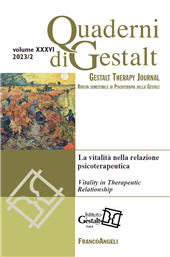Il senso di vitalità in psicoterapia della Gestalt
29-49 p.
Il lavoro esplora la dimensione della vitalità, focalizzandosi su un'ottica relazio-nale, cinestetica ed evolutiva. Il Sé è un processo di contatto che si definisce nell'esperienza situazionale con l'altro, attraverso un processo tattile, cinetico e cinestetico (Frank, 2022).are al movimento in un'ottica evolutiva ci consente di esplorare le modalità con cui prende forma un rimembrare cinestetico che emerge nella situazione presen-te. La conoscenza relazionale cine-estetica del terapeuta (Frank, 2011; Spagnuolo Lobb, 2017) rappresenta la sua "intelligenza sensoriale" con la quale cogliere il flus-so delle forme dinamiche del campo co-creato tra paziente e terapeuta. L'ottica relazionale si accompagna a un'azione terapeutica spontanea (Spagnuolo Lobb, 2011; 2014), finalizzata a rivitalizzare il sé e a coltivare un senso di speranza, intesa come quell'energia vitale, naturale e trasformativa che un terapeuta deve saper scorgere e sostenere. [Testo dell'editore].
The times we live, marked by the inability to deeply feel meaningful connections and by its post-pandemic and war scenarios, could be metaphorically described as the theater of bodily desensitization. In this scenario in which one loses perception of one's own and the other's easily, a sense of one's place in contacting the world is needed (Spagnuolo Lobb, 2013). A reflection on vitality - the subject and intent of this article - is first and fore-most a way to bring the body back to the center of our interest, and to trace what dur-ing the therapy can contribute to making us feel alive and vital. This work explores the dimension of vitality, as defined in Daniel Stern's (2011) thought on the forms of vitality, focusing on a relational, kinesthetic and develop-mental perspective. Indeed, the self is a process of contact that is defined in situa-tional experience with the other, through a tactile, kinetic and kinesthetic process (Frank, 2022).
We become kinesthetically aware when we experience a part of our body in relation to others. Through the kinesthetic dimension we feel or witness our movements and creatively adapt to the situation. Looking at movement from a de-velopmental perspective allows us to explore the processes through which a kines-thetic remembrance is shaped by the present situation. The therapist's kinesthetic relational knowledge (Frank, 2011; Spagnuolo Lobb, 2017) represents the therapist's "sensory intelligence" to grasp the flow of dynamic forms that characterizes the field co-created with his or her patient. The relational perspective thus emphasizes spontaneous therapeutic action (Spagnuolo Lobb, 2011), aimed at revitalizing the self and cultivating a sense of hope. Hope is that vital, spontaneous, transformative energy that a therapist must be able to discern and sustain (Perls et al., 1997; Spagnuolo Lobb, 2014). [Publisher's text].
-
Articoli dello stesso fascicolo (disponibili singolarmente)
-
Informazioni
Codice DOI: 10.3280/GEST2023-002003
ISSN: 2035-6994
MATERIE
PAROLE CHIAVE
- Forme Vitali, contatto, movimento, risonanza cinestetica, Conoscenza Relazionale Estetica
- Forms of Vitality, movement, kinaesthetic resonance, Aesthetic Relational Knowleadge


